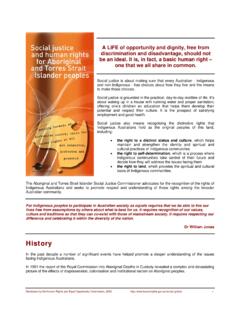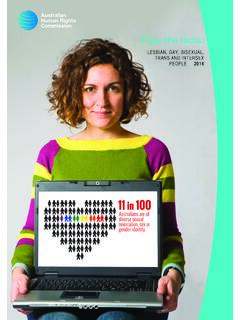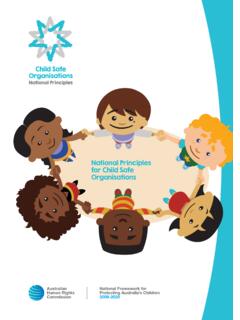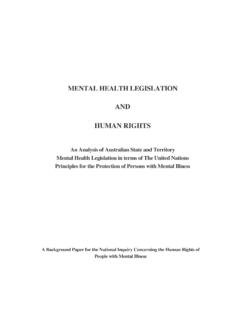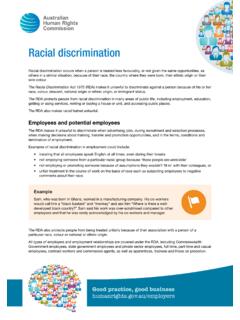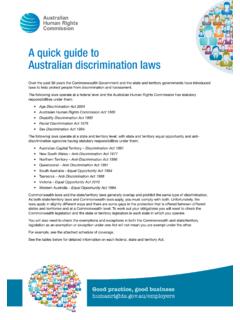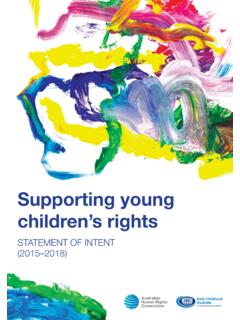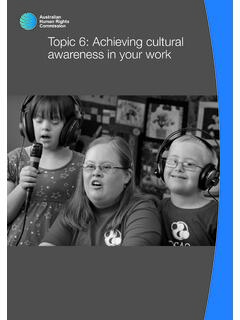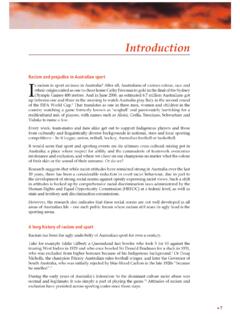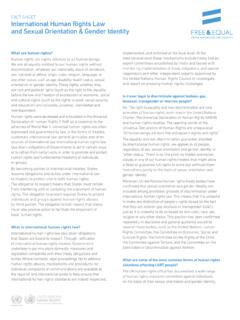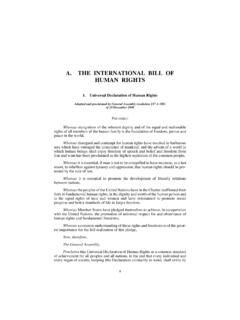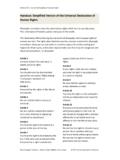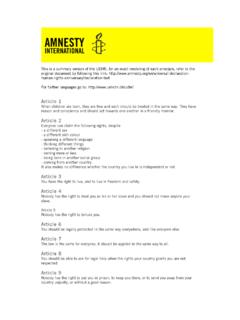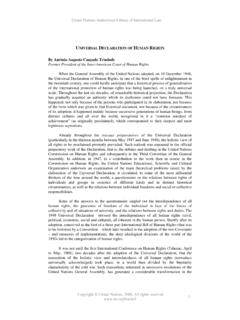Transcription of Teacher Lesson Plan An Introduction to Human Rights and ...
1 1 Teacher Lesson PlanAn Introduction to Human Rights and ResponsibilitiesKey Learning AreasYear GroupStudent Age RangeResources/PropsLanguage/vocabularyH umanities and Social Sciences (HASS); Health and Physical EducationYears 5 and 610-12 year olds Digital interactive Lesson - Introduction to Human Rights and Responsibilities Interactive Whiteboard Note-paper and pens for students PrinterHuman Rights , responsibilities, government, children s Rights , citizen, community, individual, law, protection, values, beliefs, freedom, equality, fairness, justice, dignity, 2: Introduction to the universal Declaration of Human RightsSuggested Curriculum Links:Year 6 - Humanities and Social SciencesQuestioning Develop appropriate questions to guide an inquiry about people, events, developments, places, systems and challenges (ACHASSI122)Analysing Examine different viewpoints on actions, events, issues and phenomena in the past and present (ACHASSI127)Evaluating and Reflecting Reflect on learning to propose personal and/or collective action in response to an issue or challenge, and predict the probable effects (ACHASSI132)Inquiry Questions How have key figures, events and values shaped Australian society, its system of government and citizenship?
2 How have experiences of democracy and citizenship differed between groups over time and place, including those from and in Asia? How has Australia developed as a society with global connections, and what is my role as a global citizen? Experiences of Australian democracy and citizenship, including the status and Rights of Aboriginal and Torres Strait Islander Peoples, migrants, women and children (ACHASSK135)Note: The Introduction to Human Rights and Responsibilities resource has been designed as two unique Lesson plans. However, depending on your students level of engagement and the depth of content that you wish to explore, you may wish to divide each Lesson into two. Each Lesson consists of Part 1 and Part 2 which could easily function as entire lessons on their own.
3 Inquiry and SkillsKnowledge & Understanding (History)2 Teacher Lesson PlanAn Introduction to Human Rights and ResponsibilitiesLesson OverviewTeacher NoteLearning OutcomesAimInteractivityOver two lessons students will be introduced to the concept of Human Rights and the strong link between Rights and personal responsibility. They will design their own class charter and explore the broader topic of Human Rights and responsibilities through challenging and thought-provoking teaching about Human Rights it is important to create a safe and positive classroom environment, which encourages participation and cooperation. The activities in these lessons are significant because they empower students to make rules about how they want to be treated by both teachers and their helping to create an environment where Rights are respected, students are encouraged to actively take part in advancing respect for the Rights of others in the classroom and these lessons, students will.
4 Develop an understanding of what Human Rights are appreciate the relationship between Rights and responsibilities analyse who is responsible for upholding Human Rights appreciate the meaning and significance of the universal Declaration of Human Rights apply the concepts of Human Rights to their own livesUpon completion of An Introduction to Human Rights and Responsibilities, students will be able to demonstrate a basic understanding of the concepts encompassed by the term Human Rights and underlying principles of freedom, equality, fairness and lessons are accompanied by online interactive activities to support the teaching of Human Rights . You can locate these activities at These activities are accessible on any internet enabled device however they work particularly well using an interactive whiteboard.
5 Year 5 & 6 - Health and Physical EducationBeing Healthy, Safe and Active Examine how identities are influenced by people and places (ACPPS051)Communicating and interacting for health and wellbeing Recognise how media and important people in the community influence personal attitudes, beliefs, decisions and behaviours (ACPPS057) Practise skills to establish and manage relationships (ACPPS055)Contributing to healthy and active communities Identify how valuing diversity positively influences the wellbeing of the community (ACPPS060)Personal, Social and Community Health3 Lesson 2: Introduction to the universal Declaration of Human RightsIntroductionBriefly summarise learning from the previous Lesson .
6 Key points: What is a right? A moral or legal entitlement to have or do something. Discuss the link between Rights and responsibility. Explain that Rights go hand in hand with responsibilities. When you have a right, you also have a responsibility to respect that others have that right. Explain that Human Rights are the Rights we have as Human beings. They belong to all of us, regardless of who we are or where we live, and they cannot be taken away. Pre- Lesson Quick Quiz (10 minutes) Note: You may choose to have the students complete the quiz independently (on computers or tablets), in small groups, or as an entire the pre- Lesson Quick Human Rights first became internationally recognised after World War II.
7 True. The ideas behind Human Rights have been present throughout history in many different societies and religions. However, the idea that there are basic Rights that belong to all people was internationally recognised after World War II, with the creation of the universal Declaration of Human People have the right to say whatever they want. False. While the universal Declaration of Human Rights states that everyone has the right to express their ideas and opinions, this doesn t mean you have a right to say whatever you want. Your right to express an opinion should not come at the cost of someone else s right to be treated with All people have equal Rights . True. The universal Declaration of Human Rights recognises that everyone is born free and equal in dignity and Rights .
8 We should all be treated in the same Do children have their own special Rights , as well as other Human Rights ? True. As well as the Rights set out in the universal Declaration of Human Rights , children have extra Rights that place a responsibility on adults to make sure children receive the special care and protection they need to grow up healthy and happy. These Rights are written down in the United Nations Convention on the Rights of the The police are the organisation responsible for making sure people in Australia have their Human Rights respected and protected. False. The main responsibility for upholding the Rights of all people living in Australia lies with the Australian , many groups and organisations also have some responsibility to look after Human Rights .
9 The police (as part of the justice system) look after people s right to be safe and to be protected by the law. Main Body of TeachingViewing activity: Introducing the universal Declaration of Human Rights (5 minutes) Introduce the concept and history of the universal Declaration of Human Rights by watching the video in the interactive Lesson . Show students the next slide and briefly explain how the universal Declaration of Human Rights came into being. Ask students to brainstorm why the universal Declaration might have been 2: Introduction to the universal Declaration of Human RightsTeacher Information: Following the devastation of World War II, the governments of the world came together in 1945 to form an international organisation called the United Nations (UN), dedicated to upholding peace and security.
10 One of the first actions of the newly-founded UN was to draft a document outlining the basic Human Rights shared by all people, everywhere. This resulted in the creation of the universal Declaration of Human Rights , which was adopted by the UN General Assembly in universal Declaration of Human Rights recognises the dignity of all people, and asserts that Human Rights should apply equally to everyone, no matter who they are or where they consists of thirty articles that are the basis for Human Rights protection and promotion around the world. It includes civil and political Rights , like the right to life, liberty, free speech and privacy. It also includes economic, social and cultural Rights , like the right to social security, health and has been endorsed by all countries and many countries have included its provisions in their laws or constitutions.
